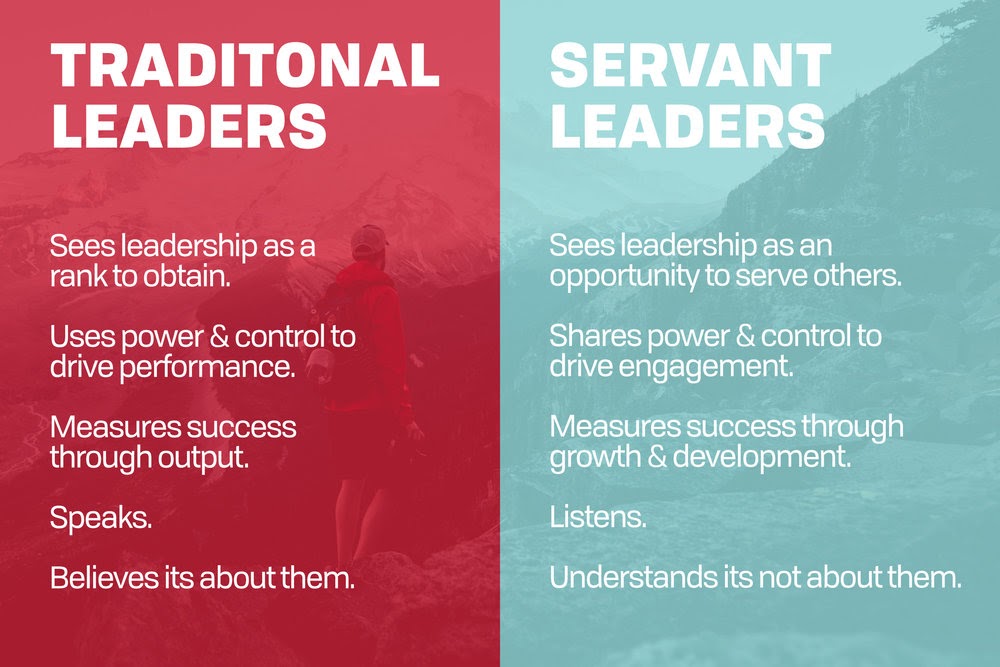The difference between a manager and a leader is slight but significant. While the former believes in intimidating employees, the latter believes in inspiring them. Servant leadership is a way of bringing forth the art of leadership in an organization. It’s a method that encapsulates the age-old adage of ‘you before me,’ the ‘you’ being the employee and the ‘me’ being the employer.
The manager-subordinate relationship is evolving with time. There is a shift happening from top-down management towards servant leaders. It’s the servant leaders who know the art of inspiring the best work out of the employees or their team members.
What is servant leadership?
Servant leadership is a philosophy, where the leader’s main goal is to serve his subordinates. It is a concept where people in managerial positions use their power and privilege to make sure that their subordinates have access to better resources and a better work environment.
It is a set of practices that aim towards building better organizations by serving humans who are working there. It aims towards building a cohesive and compassionate work environment, with the objective of serving first.
There are quite a few styles of leadership, viz. authoritative or traditional leadership, affiliative leadership, and democratic leadership. Servant leadership comes most close to affiliative and democratic leadership, as it combines its pros and its own respective traits, to form a unique leadership style; one that thrives on employee care to increase employee productivity.
It is to be noted that an affiliate leader is a pure servant leader, one who purely serves. However, in the quest of creating emotional connections, they may often lose sight of the larger goal, that of uplifting the organization. On the other hand, a democratic leader is one for whom the decision is a starting and moving point. This kind of leader seeks inputs from the team, forms and creates a decision, and then proceeds to the other points. A servant leader combines the traits of both affiliate leadership and democratic leadership.
How is servant leadership different from traditional leadership?
Servant leadership differs from traditional leadership in one key aspect. While traditional leadership focuses on organizational aims and vision, servant leadership targets employee growth and productivity, which indirectly contributes to the company’s growth.
Also, traditional leadership often tends to become self-centred, with the leader being the centre of attention. This is not the case with servant leadership.
Here’s a quick comparison of the two leadership styles:

The authoritative or traditional style of leadership is redundant in today’s scenario where compassion and overall employee development is important for the growth of the organization.
What is the origin of servant leadership?
The term servant leadership was coined by Robert Greenleaf, way back in his 1971 essay ‘The Servant as Leader.’
While writing about servant leadership, he says, “The servant-leader is a servant first. That person is sharply different from one who is leader first, perhaps because of the need to assuage an unusual power drive or to acquire material possessions”.
While he passed away in 1990, his legacy is carried on through the Greenleaf Centre for Servant Leadership in Atlanta.
Servant leadership principles can be traced back further to the works of 5th century BC Chinese philosophers such as Laozi. The philosopher wrote about this leadership concept wherein the leaders deflected the attention onto the servants.
“The sage is self-effacing and scanty of words. When his task is accomplished and things have been completed, all the people say, ‘We ourselves have achieved it.’”
Servant leadership not only manages to get employees to be their productive best but also improves employer-employee relationships. Both, in the long term, are beneficial for the organization as a whole.
Why is servant leadership important?
Greenleaf, in his essay where servant leadership originates from, has stated that the core belief of a servant leader should be to serve others, the subordinates in particular.
Here’s why servant leadership is considered a successful model for running businesses:
1. Productivity enhancement
A good servant leadership ensures that the employees are on the right path and guides them instead of focusing on mistakes. Motivated employees are always happier at work and witness a boost in productivity.
2. Trust establishment
Good servant leaders establish a transparent work culture with open lines of communication. This creates a relationship of trust between the employees and the manager, which is important to establish a positive team culture.
Servant leadership principles eventually aim towards breaking a toxic work culture and creating a work environment where communication is transparent and productivity is maximized. This is only possible when the people who work in the organization are happy and an effective servant leader is the one who can ensure that.
Servant leadership theory model
The basic tenet of a good servant leadership model is based on flexibility. Leaders are human, humans are social and dynamic in nature.
Following are the servant leadership characteristics on which a good model should be ideally based upon:
Patience
One of the basic tenets of a good servant leadership model is patience. One needs to be patient enough to give each and every thought utmost attention before coming to the ultimate judgement.
Empathy
Every employer or manager was a subordinate once. Thus, every situation should be dealt with the utmost empathy, by putting oneself in the shoes of another.
Listening prowess
A good servant leadership thrives on the power of listening. That means paying the utmost attention to each and every aspect of what has been said, pondering over it and understanding it. It is respectful and thoughtful.
Self-awareness
No servant leadership model is complete without the leader being aware of self. It is important to analyse own’s strengths and weakness too, in sync with the team.
Persuasion
Another one of the most servant leadership characteristics, and a defining one too, is the art of persuasion. A good manager must possess the art of persuading the subordinates and the team. Everyone should have a say and a stake in the success of the team.
Healing
Many times, new employees come from highly-toxic workplaces. Healing is a quite easy servant leadership characteristic which only requires the manager to create a work environment which is open and friendly. A happy and satisfied team is the one that performs well and contributes to the overall organizational productivity.
Foresight
Another important aspect of a good servant leadership model is foresight. A good servant leader should be able to apply experience and knowledge to make future decisions, for overall employee growth.
Community building
Another important servant leadership tenet is trust. Creating a trusting environment within the team is a good servant leadership principle that should be followed without fail. A team where there are no complications or complacence within the members performs impeccably.
Growth commitment
Servant leadership requires the manager to work towards the growth of the people first, along with self-growth and that of the organization. Reviews and meetings on regular intervals help achieve this. It is important to know that employees grow and learn with each task and project.
Leading by example
One of the most basic tenets of a good servant leadership model is leading by example. Often, managers reprimand subordinates for not following a certain code of conduct while themselves failing to do so. Leading by example and being a good servant leader solves the issue as the employees fall into the steps of the leader they admire.
These are the ten tenets of a good servant leadership model that should be followed for the overall betterment and growth of the organization and the employees therein.
Servant leadership examples of the aforementioned traits

The above-mentioned tenets of a good service leadership model can be better explained with the help of following hypothetical servant leadership situations:
1. Servant leadership examples – Collaboration
Let’s say that the customer service department of an organization is facing difficulties in dealing with the customers. The leader calls for a meeting and urges them to voice all their opinions together and share their thoughts on how each issue can be managed. This can be a regular exercise and the frequency can again be decided by the team, depending upon their workload.
A collaboration often brings about ideas and solutions which individually are not possible. Even though it takes working hours, this brings out productivity by bringing solutions to their problems as a whole.
2. Servant leadership examples – Leading by example
Team members of an organization do not come on time despite being regularly reprimanded for that. A servant leader initiates the change by coming before time and greeting the employees when they enter later. This induces a sense of (slight shame) and responsibility in the employees. The reason they are more inclined to follow the leader is that he or she is a servant leader. If any employee still does not fall into the pattern, he or she can be approached for the same as the communication lines are clear here.
3. Servant leadership examples – Caring
In today’s high powered corporate space, mental health has taken quite the back seat. A servant leader knows just how draining this can be on the minds of her employees. Having an on-call in-house therapist who takes care of employees with weekly personal sessions can be incredibly helpful.
How to ensure that your servant leadership style is a success?
Servant leadership is a concept that works on the basic tenets of compassion and empathy. Yet, ironically, most people find it difficult to implement the same. In today’s environment which is competitive to the core, creating a compassionate work environment may be tricky, but not impossible.

Here’s how you can ensure that your servant leadership style becomes successful:
1. Hire the right people
You should know the outcome of your actions. Hire the right people. Have the foresight to assess a person and bring self-starters to the team. Remember, micromanagement never works, it only cultivates resentment and mistrust. With the right people and the right servant leadership, this won’t happen.
2. Put others first
You have to make sure that you put your team first. Refrain from being the face of the team. Instead, be the person who represents the team.
3. Change your outlook
Servant leadership is not something that you can implement by reading a book or watching a motivational video. It is something that comes from within and can only be successful if you are flexible enough to change your outlook. You have to completely commit, it’s all or nothing.
4. Keep your communication consistent
Communication is key. Transparent and direct communication establishes trust and that is a very important key to being a successful servant leader. Make sure your communication lines are always open and the subordinates are open enough to discuss any detail, even the most menial one, without the fear of being judged or reprimanded for it. You should be the kind of leader who knows how to mend a mistake made by a team member and at the same time teach it so that it doesn’t happen in the future.
5. Plan wisely for the future
No matter how much the work, keep some time aside for planning. No organization can be static and no leader is successful if he or she is stuck at the same place at the same pace. You have to push yourself and your employees towards the next stage, at the same time improving the current one.
Servant leadership and mental health
A good servant leader is the one who understands the importance of mental health as well. They’re not just aware of how they feel, but also about the little things that can impact the mental health of their team. The following chart explains it better:

Do you need servant leadership in your organization?
Harvard research states that nearly 33 per cent of employees stay in their jobs for longer times if they enjoy their work and continuously learn something. Since servant leadership focuses on these two aspects first, it is a proven model to establish a positive work environment.
So if you’re just starting your business, establishing your team culture or are looking into ways to improve how you function now, you should consider servant leadership.
Have you ever tried running your business or your team on the servant leadership model? Has it helped your business and employees grow?
We’d love to learn more about servant leadership and feature your story here. Tag us on Twitter at @HarmonizeHQ and share your experiences!



